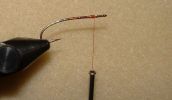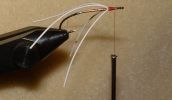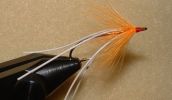
Stork by Jason Akl
article copyright
Every fly fisherman who has ever walked the rivers has one special fly in their box that is different from all the rest. These special flies are not realistic aquatic life imitations or sleekly dressed artificial but rather flamboyant, easily tied attractor patterns. A personal favorite of many good friends, the Stork is just one of these flies that does not look like anything much but is catching fish time and time again. You might wonder why fish gobble this fly down with reckless abandon, but take a second look. The body of this fly is composed of two-tone shiny tinsel that in clear water and high sun conditions gives off a tremendous amount of flash, attracting fish.
Even though this fly is mainly used in the summer months the bright orange hackle plays into large hungry rainbow’s weakness for eating spawn. Last but not least the Stork fly incorporates 4 light rubber legs. These legs swim and undulate through the water column. No large trout can resist the sultry movement created by this fantastic material in the water.
Being a wet fly the stork should be fished with the normal up and across type drift technique. Run this fly though fishy looking runs and riffles, dead drifted one or two times to stir up some excitement, and if this does not work place a few timely strips of line to get the fly to dance throughout the water column.
Materials Used in the Stork Fly Pattern
Hook: Daiichi Curved Shank Size 10
Thread: Uni-Thread Red Size 8/0
Hackle: Orange Saddle Hackle
Body: Silver/ Copper Tinsel
Legs: White Fine Rubber
 1: Start fly by placing the hook into the vice and tightening it into place securely. Attach the thread behind the hook shank and tie in one piece of silver tinsel. Wrap this down and back up the hook shank creating a nice even reflective body. After you are finished with the silver tinsel tie in a second piece of copper tinsel and repeat the wrapping process, this time stopping half way down the hook shank and working you way back to the front of the fly.
1: Start fly by placing the hook into the vice and tightening it into place securely. Attach the thread behind the hook shank and tie in one piece of silver tinsel. Wrap this down and back up the hook shank creating a nice even reflective body. After you are finished with the silver tinsel tie in a second piece of copper tinsel and repeat the wrapping process, this time stopping half way down the hook shank and working you way back to the front of the fly.
 2: At the ¼ mark on the hook shank tie in two slips of white rubber legs, folding the rubber in half and wrapping down the ends. This tying technique should create 4 separate legs, two on each side of the body.
2: At the ¼ mark on the hook shank tie in two slips of white rubber legs, folding the rubber in half and wrapping down the ends. This tying technique should create 4 separate legs, two on each side of the body.
 3: In front of the rubber legs tie in one orange saddle hackle by its tip. Wrap this hackle forward while stroking the individual hackle fibers towards the rear of the fly so that they do not get matted with successive wraps. Tie off the hackle and form a small neat head for the fly. Whip-finish the fly and cement the head.
3: In front of the rubber legs tie in one orange saddle hackle by its tip. Wrap this hackle forward while stroking the individual hackle fibers towards the rear of the fly so that they do not get matted with successive wraps. Tie off the hackle and form a small neat head for the fly. Whip-finish the fly and cement the head.
author website: visit | author bio
![]()

